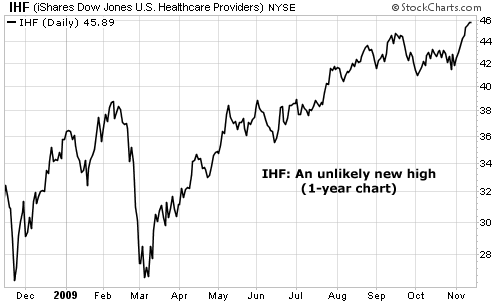| Home | About Us | Resources | Archive | Free Reports | Market Window |
Is It a Gold Bull Market or a Dollar Bear Market?By
Friday, November 13, 2009
Which is it? A gold bull market? Or a dollar bear market?
Yes, you can have one without the other... For example, gold soared 50% from early 2002 to early 2005 – but that was a dollar bear market, not a gold bull market. Let me explain... Gold went from $280 to $420 an ounce in those three years. But in terms of euros, gold was exactly flat, at around 320 euros per ounce. So that was a bear market in dollars, NOT a bull market in gold. So which is it today? My simple definition of a bull market in gold is this: When gold is rising in terms of all four of the most widely traded currencies, you're in a gold bull market. Today, we're in a gold bull market. In each of the last three months (and in six of the last 11 months), gold has risen month-over-month versus all four major currencies: the dollar, the euro, the yen, and the British pound. The numbers are astounding... Since 1971, gold has risen against all four currencies month-over-month 31% of the time. If you simply hold gold during the month after that happens, the compound annual gain in gold is an astonishing 34%. For the other 69% of the time (when gold didn't rise against all four currencies in the previous month), gold lost money over the next month. Extraordinary! Last week, I showed you a simple gold indicator with some incredible results... I said, "Simple is elegant. A few minutes a year turned $10,000 into $1.28 million over 41 years, without any number gymnastics." With that simple gold indicator, gold rises at a compound rate of 17% a year in "buy" mode. With today's simple gold indicator, gold rises at a 34% compound annual rate after it's moved up against four currencies. When you combine the two simple indicators, gold rises at a compound annual rate of 44%. Wow! Granted, both indicators are rarely in "buy" mode at the same time – it's happened 26% of the time since 1971. But importantly, we're in "buy" mode in both indicators right now... It's no surprise gold is soaring right now. But to answer the question at the beginning... Is it a bull market in gold? Or a bear market in the dollar? The truth is, unlike 2002-2005, it's both... It's a bull market in gold, AND a bear market in the dollar. The U.S. dollar has dropped nearly 15% since March against an index of the euro, pound, and yen. Both of our simple gold indicators are in "buy" mode... and both have incredible track records. There's no hurry to sell your gold yet. Good investing, Steve Market NotesHEALTH CARE: THIS WEEK'S UNLIKELY NEW HIGH
The star of this week's "unlikely new highs" department: the U.S. Healthcare Providers investment fund, symbol IHF.
IHF is a one-click way to invest in a broad swath of the U.S. heath care industry. Major holdings include Cigna (insurance), UnitedHealth (insurance), Quest Diagnostics (testing), DaVita (dialysis services), and Express Scripts (pharmacy management). The fund is up 35% in the past seven months and just registered a new 52-week high. The conventional thinking is at odds with this price action. After all, won't the government's reform efforts drive down profits for anyone who gives a flu shot, performs a lab test, or asks you to fill out an insurance form? We asked medical stock expert Rob Fannon (editor of the Phase 1 Investor) for his take on the situation... Rob says sure, reform may pressure profit margins. But remember how the ancient law of supply and demand works. The government could make health care "free" to tens of millions of people. When you make a product or service free, you create unlimited demand for it. That's why Rob recommends getting on board this trend. Profits may go down a bit, but if Washington's "free houses, cars, and health care" panderers get their way, a lot of new demand and revenue is headed toward IHF and its holdings. 
|
In The Daily Crux
Recent Articles
|

